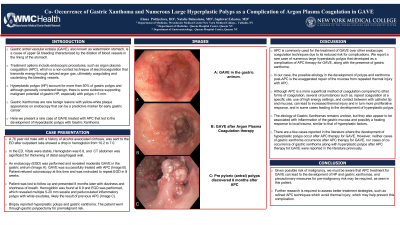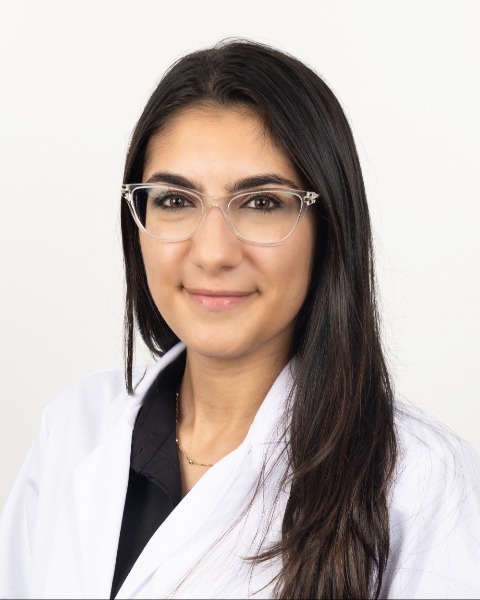Monday Poster Session
Category: Stomach
P3349 - Co-Occurrence of Gastric Xanthoma and Numerous Large Hyperplastic Polyps as a Complication of Argon Plasma Coagulation in GAVE
Monday, October 28, 2024
10:30 AM - 4:00 PM ET
Location: Exhibit Hall E

Has Audio

Elona Poltiyelova, DO
Westchester Medical Center
Valhalla, NY
Presenting Author(s)
Elona Poltiyelova, DO1, Natalie Balassiano, MD2, Saphwat L. Eskaros, MD3
1Westchester Medical Center, Valhalla, NY; 2NYU Queens Hospital, Queens, NY; 3Queens Hospital Center, Jamaica, NY
Introduction: Gastric antral vascular ectasia (GAVE), also known as watermelon stomach, is a rare cause of upper GI bleeding characterized by the dilation of blood vessels in the lining of the stomach. Treatment options include endoscopic procedures, such as argon plasma coagulation (APC), to cauterize the bleeding vessels. Hyperplastic polyps (HP) account for more than 50% of gastric polyps and although generally considered benign, there is evidence supporting malignant potential of gastric HP, especially with polyps > 5 mm. Their pathogenesis is unknown; however they are thought to be the result of excessive regeneration after mucosal damage. Here we present a rare case of GAVE treated with APC that led to the development of Hyperplastic polyps with gastric xanthoma.
Case Description/Methods: A 76 year old male with a history of alcoholic cirrhosis, was sent to the ED after outpatient labs showed a drop in hemoglobin (HGB) from 10.2 to 7. In the ED, HGB was 6.8. CT abdomen was significant for thickening of distal esophageal wall. An endoscopy (EGD) was performed and revealed moderate GAVE in the gastric antrum (Image A). GAVE was successfully treated with APC (Image B). Patient refused colonoscopy at this time and was instructed to repeat EGD in 8 weeks. Patient was lost to follow up and presented 8 months later with dizziness. HGB was found at 6.9 and EGD was performed, which revealed multiple 5-20 mm sessile inflammatory polyps with white exudates, likely the result of previous APC (Image C). Biopsy reported hyperplastic polyps and gastric xanthoma. The patient went through gastric polypectomy for premalignant risk.
Discussion: APC is commonly used for the treatment of GAVE over other endoscopic coagulation techniques due to its reduced risk for complications. We report a rare case of numerous large hyperplastic polyps that developed as a complication of APC therapy for GAVE, along with the presence of gastric xanthoma. No prior cases of gastric xanthoma after APC were reported. In our case, the possible etiology in the development of polyps and xanthoma post-APC is the exaggerated repair of the mucosa from repeated thermal injury with APC.
Given risk of malignancy, we must be aware that APC treatment for GAVE can lead to the development of HP, and precautionary measures for pre-malignancy risk may be required, as seen in this patient. Further research is required to assess better treatment strategies, such as refined APC techniques which avoid thermal injury, which may help prevent this complication.

Disclosures:
Elona Poltiyelova, DO1, Natalie Balassiano, MD2, Saphwat L. Eskaros, MD3. P3349 - Co-Occurrence of Gastric Xanthoma and Numerous Large Hyperplastic Polyps as a Complication of Argon Plasma Coagulation in GAVE, ACG 2024 Annual Scientific Meeting Abstracts. Philadelphia, PA: American College of Gastroenterology.
1Westchester Medical Center, Valhalla, NY; 2NYU Queens Hospital, Queens, NY; 3Queens Hospital Center, Jamaica, NY
Introduction: Gastric antral vascular ectasia (GAVE), also known as watermelon stomach, is a rare cause of upper GI bleeding characterized by the dilation of blood vessels in the lining of the stomach. Treatment options include endoscopic procedures, such as argon plasma coagulation (APC), to cauterize the bleeding vessels. Hyperplastic polyps (HP) account for more than 50% of gastric polyps and although generally considered benign, there is evidence supporting malignant potential of gastric HP, especially with polyps > 5 mm. Their pathogenesis is unknown; however they are thought to be the result of excessive regeneration after mucosal damage. Here we present a rare case of GAVE treated with APC that led to the development of Hyperplastic polyps with gastric xanthoma.
Case Description/Methods: A 76 year old male with a history of alcoholic cirrhosis, was sent to the ED after outpatient labs showed a drop in hemoglobin (HGB) from 10.2 to 7. In the ED, HGB was 6.8. CT abdomen was significant for thickening of distal esophageal wall. An endoscopy (EGD) was performed and revealed moderate GAVE in the gastric antrum (Image A). GAVE was successfully treated with APC (Image B). Patient refused colonoscopy at this time and was instructed to repeat EGD in 8 weeks. Patient was lost to follow up and presented 8 months later with dizziness. HGB was found at 6.9 and EGD was performed, which revealed multiple 5-20 mm sessile inflammatory polyps with white exudates, likely the result of previous APC (Image C). Biopsy reported hyperplastic polyps and gastric xanthoma. The patient went through gastric polypectomy for premalignant risk.
Discussion: APC is commonly used for the treatment of GAVE over other endoscopic coagulation techniques due to its reduced risk for complications. We report a rare case of numerous large hyperplastic polyps that developed as a complication of APC therapy for GAVE, along with the presence of gastric xanthoma. No prior cases of gastric xanthoma after APC were reported. In our case, the possible etiology in the development of polyps and xanthoma post-APC is the exaggerated repair of the mucosa from repeated thermal injury with APC.
Given risk of malignancy, we must be aware that APC treatment for GAVE can lead to the development of HP, and precautionary measures for pre-malignancy risk may be required, as seen in this patient. Further research is required to assess better treatment strategies, such as refined APC techniques which avoid thermal injury, which may help prevent this complication.

Figure: A: GAVE in the gastric antrum. B: GAVE s/p Argon Plasma Coagulation. C: Pre pyloric (antral) Polyps discovered 8 months after APC.
Disclosures:
Elona Poltiyelova indicated no relevant financial relationships.
Natalie Balassiano indicated no relevant financial relationships.
Saphwat Eskaros indicated no relevant financial relationships.
Elona Poltiyelova, DO1, Natalie Balassiano, MD2, Saphwat L. Eskaros, MD3. P3349 - Co-Occurrence of Gastric Xanthoma and Numerous Large Hyperplastic Polyps as a Complication of Argon Plasma Coagulation in GAVE, ACG 2024 Annual Scientific Meeting Abstracts. Philadelphia, PA: American College of Gastroenterology.

